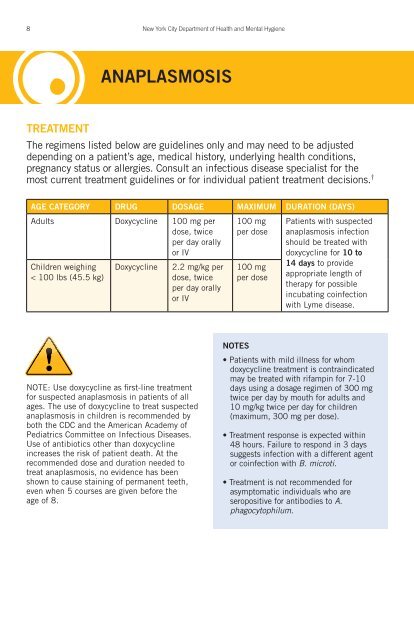tick-borne-dx-physician
tick-borne-dx-physician
tick-borne-dx-physician
Create successful ePaper yourself
Turn your PDF publications into a flip-book with our unique Google optimized e-Paper software.
8 New York City Department of Health and Mental Hygiene<br />
ANAPLASMOSIS<br />
TREATMENT<br />
The regimens listed below are guidelines only and may need to be adjusted<br />
depending on a patient’s age, medical history, underlying health conditions,<br />
pregnancy status or allergies. Consult an infectious disease specialist for the<br />
most current treatment guidelines or for individual patient treatment decisions. †<br />
AGE CATEGORY DRUG DOSAGE MAXIMUM DURATION (DAYS)<br />
Adults Doxycycline 100 mg per<br />
dose, twice<br />
per day orally<br />
or IV<br />
Children weighing<br />
< 100 lbs (45.5 kg)<br />
Doxycycline<br />
2.2 mg/kg per<br />
dose, twice<br />
per day orally<br />
or IV<br />
100 mg<br />
per dose<br />
100 mg<br />
per dose<br />
Patients with suspected<br />
anaplasmosis infection<br />
should be treated with<br />
doxycycline for 10 to<br />
14 days to provide<br />
appropriate length of<br />
therapy for possible<br />
incubating coinfection<br />
with Lyme disease.<br />
NOTE: Use doxycycline as first-line treatment<br />
for suspected anaplasmosis in patients of all<br />
ages. The use of doxycycline to treat suspected<br />
anaplasmosis in children is recommended by<br />
both the CDC and the American Academy of<br />
Pediatrics Committee on Infectious Diseases.<br />
Use of antibiotics other than doxycycline<br />
increases the risk of patient death. At the<br />
recommended dose and duration needed to<br />
treat anaplasmosis, no evidence has been<br />
shown to cause staining of permanent teeth,<br />
even when 5 courses are given before the<br />
age of 8.<br />
NOTES<br />
• Patients with mild illness for whom<br />
doxycycline treatment is contraindicated<br />
may be treated with rifampin for 7-10<br />
days using a dosage regimen of 300 mg<br />
twice per day by mouth for adults and<br />
10 mg/kg twice per day for children<br />
(maximum, 300 mg per dose).<br />
• Treatment response is expected within<br />
48 hours. Failure to respond in 3 days<br />
suggests infection with a different agent<br />
or coinfection with B. microti.<br />
• Treatment is not recommended for<br />
asymptomatic individuals who are<br />
seropositive for antibodies to A.<br />
phagocytophilum.



